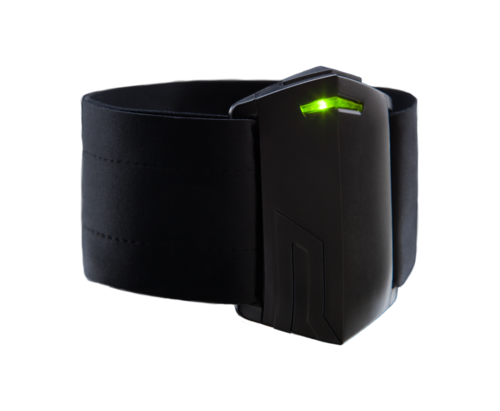
Velocity Based Training
The sports and exercise world is constantly evolving and keeping up with the latest developments and trying to decide what is just a fad or what is a real step forward in training methods is hard. Over the last few years Velocity based training (VBT) has really hit the professional sports world with a bang. Tools such as the Push Band have enabled athletes to train with Velocity as a key Intent.
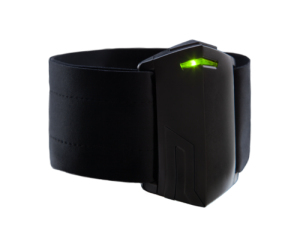
The Push Band can fit around the forearm, upper arm or waist with a different strap.
As always I’ve tried to keep as current as possible with our training methods and for the last couple of months have been putting the Push Band to good use with myself and clients. First a bit of background, the Push Band is a device which nicely fits to your forearm, upper arm or waist and links to an app on my phone. The app gives me a huge database of exercises to choose from and I all need to do is enter the load and when ready press a button and it measures the velocity of the exercise and from this the power produced.
But why? What does this device add to training and can it help us?
Intent
Our intent when training is very important, understanding what we are trying to achieve, whether to get to the top of a route, lift a certain load, do so many moves or reps or do something as quickly as possible is important to the way our brain functions. Quantifying this not only gives us a measurable outcome but gives us something to improve on. Knowing how quickly we are moving enables us to act and improve this.
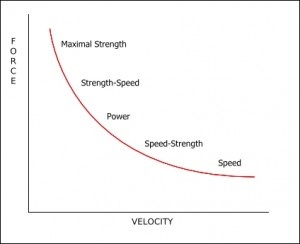
Our aim in training is to shift the force velocity curve to the right
But why? For those familiar with Strength and Conditioning you would have come across the force velocity curve. One of our key goals in training is not just to be able to lift more load and generate more force but to do this faster with greater velocity and become more powerful. Power = Force x Velocity, this simple equation is often overlooked, for most people the simplest and safest way to more power is more force (strength), but by adding in the intent of greater velocity with devices such as the Push Band we can now quantify velocity and improve that as well.
In research on the band just using it and having the measure of velocity increased vertical jump by 4.6% and horizontal jump by 2.5% (Randell et al, 2011), this highlights the value of instantaneous feedback!
Put simply Intent = Results.
Training Specificity
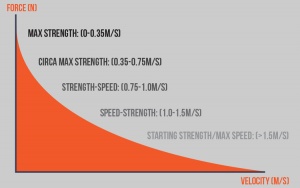
Force velocity curve with suggested velocities for training
We also know that to train Strength, Strength-Speed or Speed Strength we should be aiming for certain velocities. For instance, for Max Strength training we’re looking for velocities of between 0-0.34m/sec if you’re way above this then you need to increase the load. Similarly if you’re trying to train power (Strength-Speed) and you’re down at 0.3m/sec then you need to drop some load!
Feedback Based Training
This is one area I love about the band is the continuous feedback, being able to monitor fatigue of the set, consistency and average velocity allows me to make reliable decisions on load and progress. Being able to able to measure velocity loss during the set gives a reliable measure to whether I should increase the load or not. Being able to compare velocity between sets gives me a good picture of my fatigue during the session and possibly whether I should do more sets of the exercise. When training stability looking for consistency between reps gives me a good measure of if the training is improving stability. With this tool online as well I can monitor my athletes training and make informed adaptations to their training.
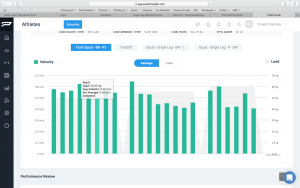
Analysing a training session based on velocity
The implication of this to athletes training close to their limit and knowing when to back off due to fatigue or when to train hard is incredibly valuable. Coaches can use the Push Band with simple vertical jump tests to also measure fatigue and make decisions on training. For those with conditions where their fatigue levels are linked to their health particularly some Para-Athletes this feedback will enable better monitoring of training and decisions on when to push on or back off.
Competitiveness
Whether we like or not we all are a bit competitive, whether against ourselves our team mates or in a competition. The Push Band achieves this by giving us something to work on, something to improve and a huge part of its success for me is this. I now know what needs fixing and can get to work fixing it.
Final Thoughts
The band certainly isn’t for everyone in the climbing world, but if you’re training and want a session to session analysis of your training then this is a must. VBT is in its infancy. But with features such as Free Movement its application to developing power and speed in climbing is very relevant. With climbing in the 2020 Olympics, looking into technology such as this is a must and as coaches getting a Push Band and starting playing is a necessity.
Key Points
- Let’s move quicker and move explosively in general.
- Campussing – lets campus with the intent of maximum velocity!
- Measure fatigue – train harder or train less depending on it